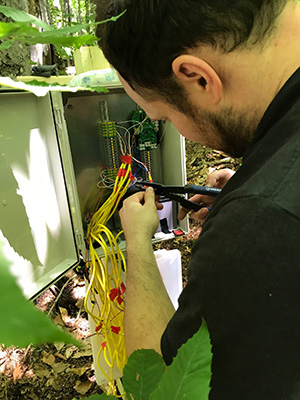By: Chris Woodall
USDA Forest Service Northern Research Station
Co-lead of the Second College Grant ASCC Site

Photo Credit: Chris Woodall,
USDA Forest Service Northern Research Station
During the ASCC planning workshop for the Second College Grant installation in the hardwood forests of northern NH, it became apparent that although we expect precipitation to become more episodic in the future, we have very little understanding of how rain events effect the moisture of dead wood over short time steps. Dead and downed wood serves not only as a critical habitat and increases the structural complexity of forests but also may mitigate the overland flow of intense rain events. In contrast, dead wood can serve as sources of fuel during times of drought and extreme fire weather. Given recent advances in micro sensor development and associated data management, the potential exists to extend such technologies to this forest management issue.
In partnership with Dartmouth College’s Thayer School of Engineering and Plymouth State University, a downed dead sugar maple log and surrounding soil was monitored at the Hubbard Brook Experimental Forest with nearly 80 sensors to detect changes in moisture at 15-minute intervals during the summer of 2018. Based on initial findings, the hope is to develop a more streamlined deployment of sensors per log potentially using wireless technology for testing during the summer of 2019 at the Second College Grant ASCC installation.
As part of the project, numerous trees were intentionally felled and left on-site to evaluate their potential benefits. With a streamlined moisture monitoring technology in hand, we can more fully evaluate the modes by which down dead wood interacts with soil and rain fall events in terms of forest dynamics (e.g., regeneration, production, or fire hazards). Development of efficient dead wood moisture technology could inform wildfire management efforts around the Nation.

